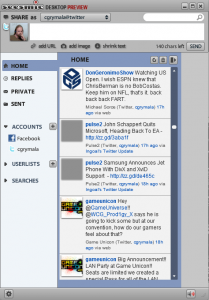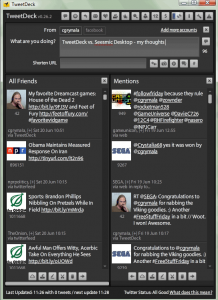There are a handful of various desktop applications that can be used to track Twitter on your computer. In this article, I will be comparing two of those applications: Seesmic Desktop and TweetDeck. For the purposes of this review, I am using TweetDeck 0.6.2 and Seesmic Desktop 0.2.1.
On the surface, both applications are very similar. Listed below are some of the general features you’ll find in both TweetDeck and Seesmic.
- Use multiple Twitter accounts (just added in TweetDeck v0.6.x)
- Monitor Facebook friends’ status
- Monitor Twitter search results
- Post to Twitter
- Post Facebook status
- Send direct messages to Twitter followers
- Shorten URLs using various URL shortening sites
- Upload pictures to TwitPic (and a few others) and post to Twitter
- Shrink your Twitter post using TweetShrink
- Adjust the specific amounts of time between checking for Twitter “following” updates, direct messages, search results, etc. to utilize your 100 API calls per hour to its fullest
- Follow/Unfollow/Block Twitter users from within the application
- Notification of new updates via a pop-up on your desktop and a sound (can be configured through the application settings)
- Available for Linux, Mac and Windows (via Adobe AIR)
 Now, I will outline the features available in Seesmic Desktop that are not yet available in TweetDeck:
Now, I will outline the features available in Seesmic Desktop that are not yet available in TweetDeck:
- View Twitter updates and Facebook updates together in a single column
- Columns automatically resize themselves (within reason) to fit in the width of the window
- View your timeline (Sent) from Twitter in its own column, without being mixed in with all of the people you are following
- The Facebook account shows all updates from your Facebook friends (TweetDeck only shows status updates, and only shows the most recent from each friend)
- Choose which URL shortening service, pic upload service, etc. you want to use when you are actually posting it (TweetDeck requires you to set the default sites to use in the application settings)
 Following are the features available through TweetDeck that are not yet found in Seesmic Desktop:
Following are the features available through TweetDeck that are not yet found in Seesmic Desktop:
- Preview shortened URLs (if you click on a shortened URL, TweetDeck pulls some information about that URL and shows it to you – including the real URL to which that short URL redirects)
- An iPhone application is also available, and you can sync your TweetDeck columns between your iPhone and your computer
- Post the same status update to your Facebook account and your Twitter account in one action
- Auto-complete usernames (from a list of the people you’re following, I believe) as soon as you type the @ symbol – This feature can be turned on or off in the application settings
- Auto-include hashtags when you reply to someone’s post (this feature can be turned on or off in the application settings)
- Translate an update you are preparing to post
- View a list of hashtags you’ve used recently so that you can insert it into your post
Now, I’ll try to outline some of the differences between the two and some of the features I’d like to see that aren’t available in either:
- TweetDeck does not allow you to resize or reorder your columns in any way (except the option to use “narrow columns,” which makes all of your columns about 10 or 15 pixels narrower than the standard size). However, Seesmic Desktop, as mentioned above, will sort of automatically resize your columns to fit in the width of the window. Still, though, Seesmic does not offer any way to manually resize your columns.
- Although Seesmic shows all of your updates (Twitter, Facebook, etc.) in one column, there doesn’t seem to be a way to show them in separate columns. TweetDeck only offers the ability to show them in separate columns.
- There does not seem to be a way, in either application, to indicate which Facebook updates are displayed when you add your Facebook status
- Within Seesmic Desktop, you can “like” a Facebook update or tweet it. In TweetDeck, you can either e-mail the Facebook status update or tweet it. Neither application allows you to comment on the Facebook updates.
Personally, I prefer the interface of Seesmic Desktop over the TweetDeck interface. However, the feature set currently available in TweetDeck offers more of the functionality I want, so I’m working mostly within TweetDeck. The number one feature that would absolutely need to be added to Seesmic Desktop before I would consider switching is the short URL preview. I also would want Seesmic to introduce the auto-complete usernames and auto-include hashtags. I must admit that I also am becoming a big fan of the fact that I can sync my TweetDeck columns between platforms (as long as I sync them with my iPhone, I can also sync them between Linux and Windows and between my work and home computers – which is really cool).
That said, if TweetDeck introduces a way to comment on Facebook updates and a way to resize the columns (automatically and/or manually), I would probably stop considering switching to Seesmic Desktop.
As a final word, I will issue this minor warning: If you use TweetDeck and Seesmic Desktop at the same time (as I did while writing this review to allow for easy comparison), you will most likely run out of Twitter API calls before the hour is up (I ran out about 15 minutes early).
2 Responses
Following are some of the comments and corrections from the CenterNetworks version of this post (http://www.centernetworks.com/tweetdeck-seesmic-comparison#comments):
1) I made a typo when referring to the version number of TweetDeck being reviewed. The version number should 0.26.2 rather than 0.6.2.
2) The RC1 version of Seesmic 0.3, which is available as a “private” beta (you just have to register at Seesmic to get a download link), now allows you to post to multiple Twitter accounts and your Facebook account at the same time.
3) In TweetDeck, you can reorder the columns by simply clicking the arrow at the bottom of the column to shift it left or right. I completely overlooked that button when reviewing the app.
4) In Seesmic, you can comment on Facebook statuses by clicking the “@” symbol (I assumed that it would tweet the status, but I was wrong).
5) While it is still not possible to perform a live sync between various computers with Seesmic, there are some directions (http://bit.ly/QoQaQ) explaining how to copy the config files from one computer to another to migrate your settings from one to the other. However, there is potential for issues when trying to use the same config files across different platforms, and I see no way to configure the application to look in a different location for those files (so that, for instance, on a dual-boot system, you could use the same config files for both platforms).
[…] post isn’t a review of either or both – you can read one like this recent and good comparison review by HTMLCenter a couple of months ago (and Google for others although most results are reviews of older versions […]